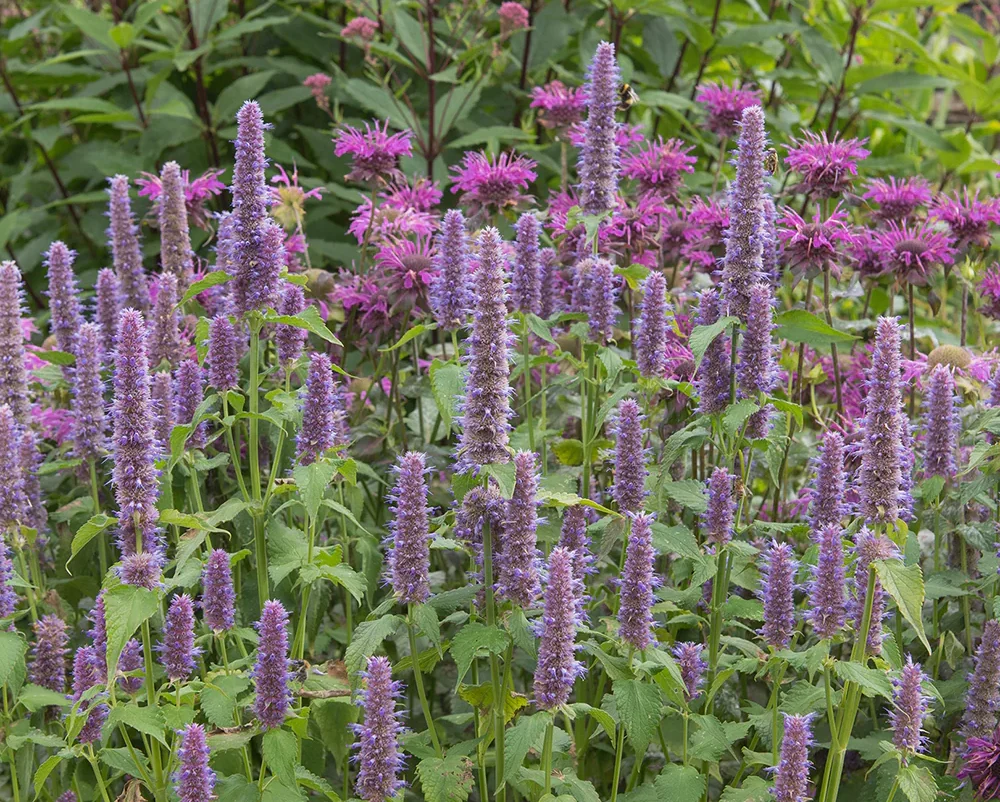
Description:
Agastache foeniculum belongs to the mint family (Lamiaceae), however it is not the same as anise (Pimpinella anisum) or hyssop (Hyssopus officinalis). The scent of its leaves is mildly anise-like, while other people think it smells more like basil or French tarragon. Depending on the cultivar, the plant’s flower spikes range in colour from blue-lavender to purple and are borne on tall stems with dull green leaves. With toothed margins similar to those of ordinary mint, each leaf is four inches in length.
Habitat
Native to portions of the Midwest and Great Plains (Wisconsin to Ontario, west to British Columbia, and south to Colorado), this perennial forms clumps. It grows in dry highland wooded areas, plains, natural prairies, and fields. It attracts hummingbirds, butterflies, and bees with its profuse blooms, which occur from mid- to late summer to early fall.
Uses
Although the plant’s parts are all utilized for various purposes, the leaves are the most beneficial. Hyssop leaves can, in fact, be used in herbal tea or, when fresh, added sparingly to a salad together with other greens. Dried leaves can be applied topically to heal wounds, fevers, coughs, and diarrhea.

Species
The following are a few of the most popular types:
The hybrid flower ‘Alabaster’ is creamy-white in colour. Compared to most other hybrids, the leaf has a paler green hue. Not as bushy as some other varieties of anise hyssop, plants reach a height of approximately 3 feet.
“Black Adder” bears reddish-violet blooms with dark buds. Its growth is slower and less robust than that of other species.
A tall hybrid of Agastache ‘Desert Sunrise’ and A. foeniculum, ‘Blue Blazes’ This hybrid, which is hardy up to USDA Zone 5, features lavender purple blooms that appear to glow in the sunlight, along with pinkish calyxes.
A sterile cross of A. rugosa and A. foeniculum is called “Blue Fortune.” Particularly dense and powder blue in colour are the flower spikes. Large, rich green leaves are present. It peaks in the middle of summer. Flowers don’t produce seeds, thus they last a very long time. Plants are three feet tall.
Consider the anise hyssop variation “Blue Fountain” or “Blue Spike.” Its blossoms are a clear blue colour.
The powder blue, long-lasting flowers of Golden Jubiliee’ contrast nicely with its chartreuse leaves. This hardy plant can withstand extreme heat and humidity.
Violet-blue blooms with reddish-purple calyxes are shown in ‘Liquorice Blue’.
The flower spikes of “Purple Haze” are narrower than those of many other anise hyssop cultivars. Spikes may be attractive to smaller pollinators that can fit inside, but they may not draw in as many huge native bees due to their narrow shape.
Plant Care
- Light
Anise Hyssop prefers full sun. It can grow in some shade, but not enough sunlight will cause it to become lanky.
- Soil
Well-drained, fertile soil is ideal for growing anise hyssop; a mixture of sand, loam, chalk, or clay usually works well. Try to stay away from very thick soil as this can hinder the roots’ ability to take hold and even cause root rot. Furthermore, the pH of your soil should be as near to neutral as possible; if it is too acidic, you can adjust it using lime.
- Water
If there isn’t any rain for the first four weeks, water newly planted anise hyssop once a week. Water deeply and gradually to encourage spreading, deep roots. Stop watering plants once they become established. They are incredibly simple to grow and maintain since they can withstand drought.
- Fertilizer
Every other year, sprinkle the base of your Anise Hyssop plant with roughly a bucket of organic compost and feed it in the early spring. A couple of inches of soil should be left between the compost and the main stem of the plant. Be careful to concentrate on the roots.
Table





